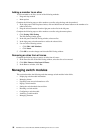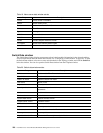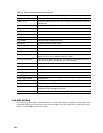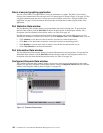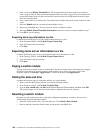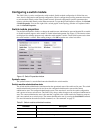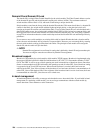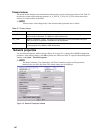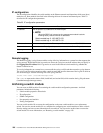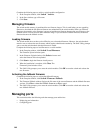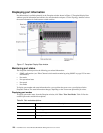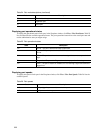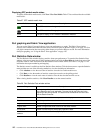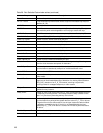
106 Intel Blade Server Switch Module SBCEFCSW Management and User’s Guide
Domain ID and Domain ID Lock
The domain ID is a unique Fibre Channel identifier for the switch module. The Fibre Channel address consists
of the domain ID, port ID, and the Arbitrated Loop Physical Address (ALPA). The maximum number of
switch modules within a fabric is 239, with each switch having a unique domain ID.
Switch modules come from the factory with the domain IDs unlocked. This means that if there is a domain ID
conflict in the fabric, the switch module with the highest principal priority, or the principal switch, will
reassign any domain ID conflicts and establish the fabric. If you lock the domain ID on a switch module and a
domain ID conflict occurs, the switch module with the higher WWN will be isolated as a separate fabric, and
the Logged-in LEDs on both switch modules will flash to show the affected ports. See “Set Config command”
on page 29 for information about the switch module keyword and the Domain ID Lock and Principal Priority
parameters.
If you connect a new switch module to an existing fabric with its domain ID unlocked and a domain conflict
occurs, the new switch module will be isolated as a separate fabric. However, you can remedy this by resetting
the new switch module or taking it offline then back online. The principal switch module will reassign the
domain ID, and the switch will join the fabric.
✏ NOTE
Domain ID reassignment is not reflected in zoning that is defined by domain ID and port number pair.
You must reconfigure zones that are affected by domain ID reassignment.
Broadcast support
Broadcast is supported by the switch module, which enables TCP/IP support. Broadcast is implemented using
the proposed standard specified in Multi-Switch Broadcast for FC-SW-3, T11 Presentation Number T11/02-
031v0. The FSPF is used to set up a fabric spanning tree used in transmission of broadcast frames. Broadcast
frames are retransmitted on all ISLs indicated in the spanning tree and all online F/FL_Ports. Broadcast zoning
is supported with ACL and VPF hard zones. When a broadcast frame is received, these hard zones are
enforced at the F/FL_Port. If the originator of the broadcast is in a hard zone, the frame is retransmitted on all
online F/FL_Ports within the hard zone. If the originator of the broadcast frame is not in a hard zone, the frame
is retransmitted on online F/FL_Ports that are not in a hard zone.
In-band management
In-band management is the ability to manage switch modules across interswitch links. If you disable in-band
management on a particular switch module, you can no longer communicate with that switch module by
means other than a direct Ethernet or serial connection.



